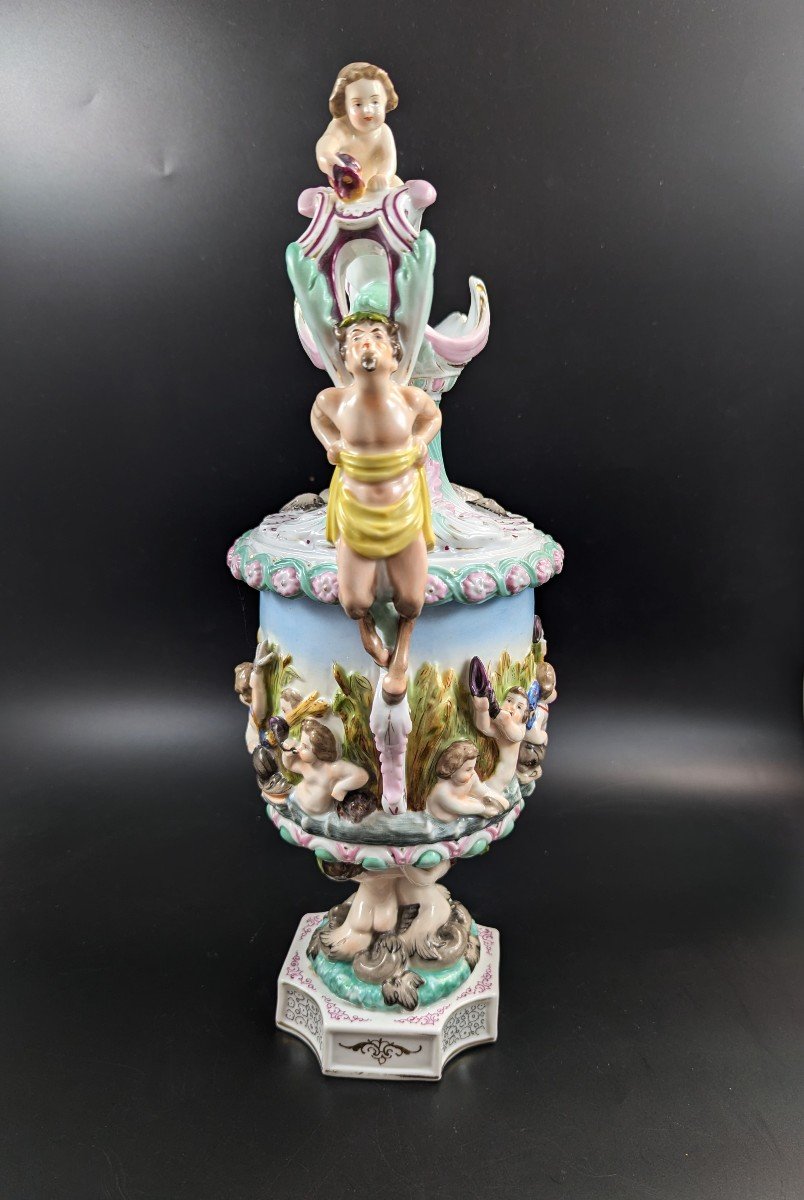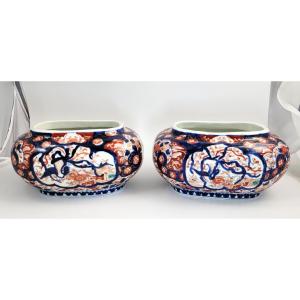Rare Volkstedt Capodimonte-style porcelain ewer with mythological figures, hand-painted and gilded, in the manner of Christian Nonne, c. 19th century
This exceptional and very rare porcelain jug was produced in the celebrated style of Capodimonte, attributed to the prestigious Volkstedt Porcelain Manufactory of Germany. Finely hand-painted and richly gilded, the piece dates to the late 19th century and showcases the exquisite craftsmanship and luxurious design for which Volkstedt porcelain became renowned.
The ewer is elaborately decorated in vibrant colours and gold on all sides with intricate moulded bas-relief elements depicting mythological figures from Greek and Roman mythology: a dramatic scene with satyrs, playful putti, mermaids, dolphins, and a hippocampus. The twisted handle is adorned with a satyr figure climbing towards the top, surmounted by a putto, while the base is supported by three mermaids emerging from stylised waves. The entire composition reflects the influence of Renaissance and Rococo styles, imbued with an opulent and noble character.
The porcelain is hand-decorated in soft pastels, turquoise, lilac, green, and gold, capturing both romanticism and classical elegance. The remarkable attention to anatomical detail, textural modelling, and fluid motion reflects the highest standards of Volkstedt’s artistic production. This luxurious, finely modelled piece is executed in the style of Christian Nonne, one of Volkstedt’s most influential porcelain artists during the late 18th century.
The base bears an impressed "55" and a blue underglaze mark, identifying it with the historic Volkstedt manufactory. This ewer is not only a collector’s piece for antique porcelain enthusiasts but also a magnificent decorative centrepiece for interiors seeking classical, neoclassical, or romantic revival aesthetics. Ideal for display in formal settings, or as a highlight in a collection of European fine ceramics.
Historical background
The Volkstedt Porcelain Manufactory was founded in 1762 by Georg Heinrich Macheleid in Thuringia, Germany. It quickly established a reputation for producing exceptional porcelain figurines and decorative art in the style of Meissen and Dresden.
Christian Nonne, a Swiss-born porcelain master, became one of Volkstedt’s finest directors between 1767 and 1797. Under his leadership, the factory flourished, producing porcelain pieces characterised by neoclassical influences, mythological subjects, and exquisite bas-relief work. Nonne’s contributions helped cement Volkstedt’s reputation for innovation and artistry, with a focus on mythological figures, classical themes, and luxurious Rococo decoration.
Throughout the 19th century, Volkstedt continued to adapt to new artistic movements, incorporating romantic and naturalistic themes into its designs, while maintaining the exceptional technical skill and hand-painted craftsmanship that defined its legacy.
Measurements
Height: 38 cm / 14.96″
Width: 18 cm / 7.09″
Depth: 13.5 cm / 5.31″
Weight: 1895 g
Condition
The jug is in remarkable antique condition. There are no visible signs of cracks, breaks, or restoration. The colours remain vibrant and the gilding is beautifully preserved, with only very minor signs of age consistent with careful handling.
Shipping & packaging
Fully tracked and insured delivery.
Shipping cost includes professional packaging, handling, and postage.
Carefully packed using recycled materials.
Please review all photos carefully, as they form part of the description, and feel free to ask any questions.


















































 Le Magazine de PROANTIC
Le Magazine de PROANTIC TRÉSORS Magazine
TRÉSORS Magazine Rivista Artiquariato
Rivista Artiquariato